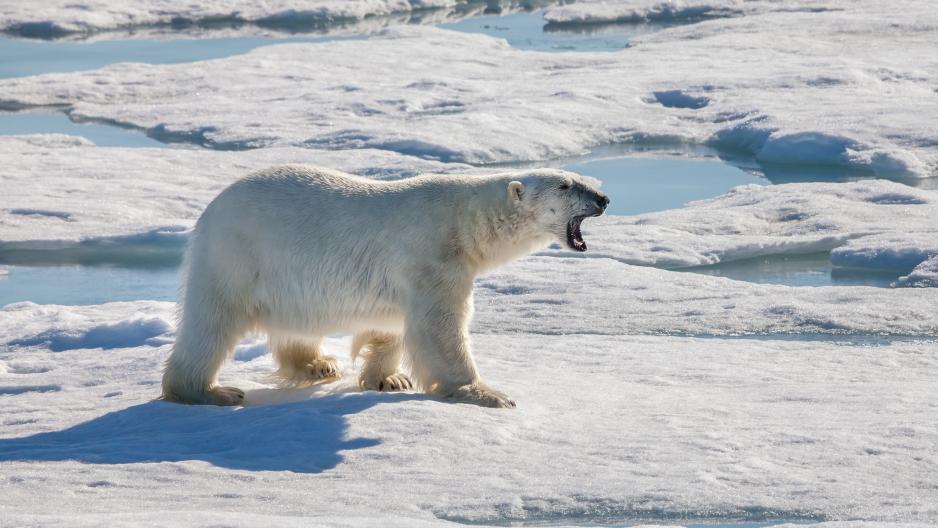Too Many Polar Bears?

Polar bear (Photo: Andreas Weith/Wikimedia Commons)
The Government of Nunavut has released a new draft management plan that contradicts conventional scientific evidence and claims that there are too many polar bears in parts of Canada.
The Government of Nunavut released their draft management plan for polar bears last week. This new draft management plans argues that there are too many polar bears in areas of Nunavut and this is increasing interactions with people. This comes up after two deadly interactions with polar bears in the last year, one in Arviat in July and one outside of Naujaat in August.
Draft plan and meeting
The Government of Nunavut released this draft plan last week and held a four-day Nunavut Wildlife Management Board hearing in Iqaluit. This draft management plan is based on several years of research as well as extensive consultations across the territory. It is now up to the Wildlife Board to approve, reject, or come up with changes to this plan.
As mentioned, the recently released management plan believes that there are too many polar bears. But it goes further saying that this could lead to public safety challenges. In fact, “Inuit believe there are now so many bears that public safety has become a major concern.”
These thoughts from the Government of Nunavut are not new. The first version of this management plan from 2015 states, “pressure from national and international environmental and nongovernmental organizations, climate change advocates, and the general public at large to conserve and protect polar bears has created contention about whether polar bear populations still need to increase, despite the fact that Inuit believe there are now so many bears that public safety has become a major concern.”
This growth trend has been going on for many years. In fact the 2015 document goes on to say that, “Inuit do not believe there is a serious conservation concern because polar bears have increased in numbers over the last 50 years and are highly adaptable to some environmental changes.” This sentiment was reiterated in the most recent draft management plan.
Various organizations submitted written comments to the process. This includes the Arviq Hunters and Trapper Organization whose comments echo the concerns. Specifically, “a concern we have regarding the polar bears is that the community do see the numbers have increased, and many polar bears roam around the community, and at the camp sights.”
Interactions
The draft plan states that these higher interactions between polar bears and people is due to the increase of the population and not due to climate change. This is in direct opposition to what various other governments in Canada have said including the Ontario Government, “The greatest threat to Polar Bears is the alteration of their habitat due to climate change [...] This also makes them more susceptible to other threats such as increased human-bear interactions, changes in land and sea uses by humans, pollutants, and potential unsustainable harvest.”
One of the reasons that there is a difference in the thought, both about the size of population and the reasons of interaction, is that the draft management plan focuses predominantly on Inuit Knowledge, also known as Inuit Qaujisarvingat (IQ).
The Kitikmeot Regional Wildlife Board also made a written submission to the draft plan, directly commenting on the role that IQ plays versus scientific knowledge, “[Inuit] know what we are doing and western science and modeling has become too dominant in the wildlife management system. These models make too many assumptions and do not consider Inuit Qaujimajatunqangit.”
In the background information regarding this draft management plan, the Nunavut Government says, “The new draft plan better reflects Inuit Qaujimajatuqangit and is more accessible to Nunavummiut.”
Federal government response
In the Canadian Government’s comments to the draft polar bear management plan, Environment and Climate Change Canada (ECCC) says that they, “support the Nunavut Polar Bear Co-Management Plan and look forward to its successful implementation.”
However, they go on to log three topics that they would want further revised: the goals and conservation objects, climate change, and threats to the population. The first concern includes the characterization of polar bears as an animal that needs either population maintainance or reduction. The government’s second concern states that, “It is ECCC’s view that a management plan that does not seriously consider the potential negative impacts of climate change on polar bears over both the short- and long-term does not demonstrate due diligence with respect to threat identification and mitigation.” And the final concern is that the ECCC, “recommended that the description and assessment of threats be separate from the challenges”
